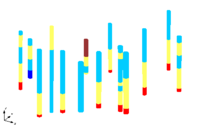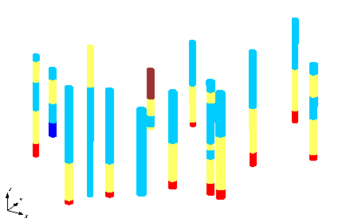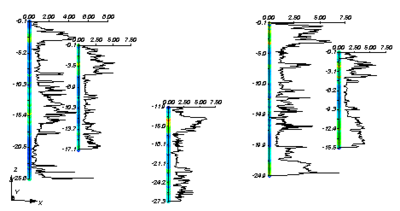GMS:Boreholes
The Borehole module of GMS can be used to visualize boreholes created from drilling logs and to construct three-dimensional cross sections between boreholes. These cross sections show the soil stratigraphy between two boreholes.
The borehole module contains its own set of tools and commands for manipulating borehole data as well as its own display options. Borehole data can be converted to other types of objects such as 2D Scatter Points, TINs, 3D Meshes.
Types of Borehole Data
A borehole can contain either stratigraphy data or sample data or both.
Stratigraphy
Stratigraphy data are used to represent soil layers that are encountered in a soil boring. The soil layers are represented using contacts and segments as shown below. A segment represents a soil layer and a contact is the interface between two segments.
Sample Data
Sample data represent data obtained by continuous sampling along the length of the hole. Cone penetrometer data and down-hole geophysical data are examples of sample data. The figure below shows an example of sample data being displayed. Sample data are stored in datasets which can be manipulated in a similar fashion as other datasets in GMS.
| GMS – Groundwater Modeling System | ||
|---|---|---|
| Modules: | 2D Grid • 2D Mesh • 2D Scatter Point • 3D Grid • 3D Mesh • 3D Scatter Point • Boreholes • GIS • Map • Solid • TINs • UGrids | |
| Models: | FEFLOW • FEMWATER • HydroGeoSphere • MODAEM • MODFLOW • MODPATH • mod-PATH3DU • MT3DMS • MT3D-USGS • PEST • PHT3D • RT3D • SEAM3D • SEAWAT • SEEP2D • T-PROGS • ZONEBUDGET | |
| Aquaveo | ||


